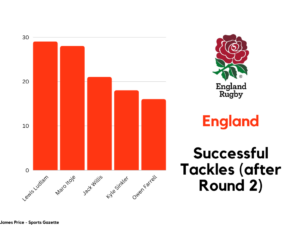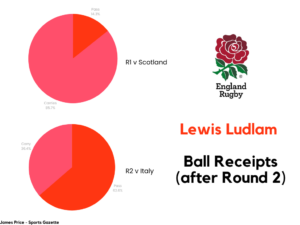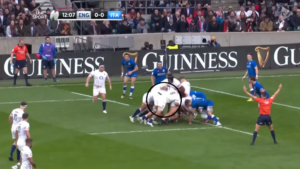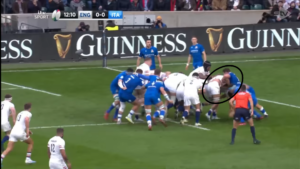Lewis Ludlam: the unsung hero of England’s back row
As just one of two England forwards to play every minute of the 2023 Six Nations so far, writer James Price analyses his performances to make the case that Lewis Ludlam is the answer for England at 6.
“Lewis Ludlum provides the percussion in the orchestra. Any orchestra needs a strong drum beat to operate effectively, that’s him.”
The wise words of my dad, a faithful season ticket holder at Northampton Saints, when I asked him to describe what makes Lewis Ludlam so good.
I think he hits the nail on the head. It’s been tacitly agreed that Ludlam has been great for England in the Six Nations, yet attention on his performances have gone little further than lip service.
After the opening two rounds, data from Stats Perform show the versatile back-row leads England in tackles (29) as well as ranking second in dominant tackles (4), carries (22) and lineout takes (11). He was inexhaustible in attack versus Scotland with 18 carries as well as giving the final pass for Max Malin’s second try; against Italy he showed his talents in defence making a mammoth 22 tackles, more than anyone else on the field.

Yet, with Courtney Lawes set to be back in the fold against Wales, Jack Willis in startling form on his return and Tom Curry sure to be looked at when he is fully fit, dropping Ludlam seems almost inevitable. A consequence of England’s frankly ridiculous depth at 6, 7 and 8, Ludlam has never quite been spoken of in the same breath as his contemporaries.
While it would be no surprise to see Borthwick switch Lawes in for his club mate, I believe this decision is far less straightforward than it may at first seem. Ludlam’s attributes are such that they often go unnoticed; in the next few hundred words, I will attempt to display them.
The subtle solider
A good bassline is usually simple yet intricate, pulling together the whole tune and giving root to its rhythm. If my dad’s theory has merit, Lewis Ludlam is England’s Kim Gordon.
The reason Ludlam rarely gets the critics applause is because his key role is as a facilitator, making space and time for others to bask in the glory.
Contrary to the more traditional role of a 6, such as the likes of Italy’s Sebastian Negri, Ludlam’s task in England’s attack is not as a gain line ball-carrier. His style is not ‘in your face’ but rather he operates to preserve the momentum and speed of play.
Ludlam played this part very differently, but equally effectively, against Scotland and Italy.
Versus Scotland it was all about his decision-making with ball in hand. The flanker recorded 18 carries for an impressive 73 meters carried, but what he did in the contact area was set up play for others.
There was a subtle but perfect example in the 23rd minute.
England are roughly ten meters out and bruising the Scottish defence with their forward carriers. Ludlam, not looking to make yards in this situation, instead drops his body height early so he can present the ball on a plate for Jack van Poortvliet, less than two seconds after contact.


The same determination to facilitate for others was evident in the 32nd minute.
Spotting the mismatch with Scotland prop WP Nel, Ludlam aims for him while keeping his arms free, allowing the offload straight to the arms of Alex Dombrant.

The pass didn’t quite stick on this occasion, but his intent to supply the ball for others is clear.

This pace at the breakdown injected by Ludlam and others certainly paid off when you look at the numbers. With 66% of England’s rucks under 3 seconds in comparison to Scotland’s 49%, its clear Ludlam’s 18 carries played a huge part in keeping England’s attack flowing.
In contrast, against Italy, Ludlam’s facilitating function came not from carries but from distribution. Ludlam was on carrying duty just 4 times across the entire 80 minutes (14 less than against Scotland), instead opting to pass 64% of the time he received the ball (in comparison to 14% against Scotland).

With the addition of ball-carrying centre Ollie Lawrence to the backline, Ludlam’s role was once again as a supplier. From the week before he managed to completely alter his style, all to serve the interest of the team at large.
In both games, while Ludlam goes about his work in contrasting manners, what’s clear is that his efforts, almost by definition, go under the radar. While it’s Dombrandt’s job to be imperious with his running lines and Willis’ role to be omnipresent at the breakdown, Ludlam’s task is to sharpen his quill and fill in the leftover paperwork.
The notion of balance is often something thrown around when talking selection, but I think it makes total sense in the case of this England back-row. Dombrant and Willis have licence to do what they do best with Ludlam as their foil.
Accomplished in adversity
It’s not just what Ludlam does in an England shirt, but more importantly when he does it.
The Saint has had two noticeable purple patches this Six Nations, both of which came in periods where England were on the back foot.
Versus Scotland, Ludlam rose to the challenge as the visitors moved to within one point following Ben White’s try. In the 52nd minute he chases England’s kick off, demolishing Matt Fagerson backwards to set the tone.
10 minutes later and the flanker was still hard at work. In the 62nd minute England drive from the lineout to set up an attack, Ludlam carrying no less than three times in the ensuing minute of attack, ultimately leading to a penalty and three points.

Against Italy, Ludlam’s period of brilliance came in the dying embers of the game. Italy were chasing in the final minutes and Ludlam was sure to silence any last attacking efforts, exemplified by his sizeable hit on Tommaso Allan in the 73rd minute.
His shirt visibly muddied more than anyone else, Ludlam is on his last legs. He stretches to make a low shot in the 77th minute and then, 20 seconds later, leads the line again and hits Edoardo Iachizzi as he receives the ball.

What is very noticeable in these periods is that it’s always Ludlam dictating the line-speed in defence. When defending at the Y and Z positions his eagerness to get off the line and close down ball carrier’s space is clear, likely something he’s developed over time to deal with men bigger than himself and stop them building up speed.
The takeaway is that Ludlam is an incredibly determined and naturally intelligent defender. Not only does he show up defensively in the pivotal moments, but he choices are calculated and timed to perfection.
Durable. Versatile. Reliable.
After 160 minutes where the 6 shirt has been fully his own, Ludlam has proved he’s no longer a fringe England player. Leading by example and putting in the effort at key moments, he’s delivered exactly what England needed.
His versatility has also been such a crucial asset. In final stages of both the Scotland and Italy games Ludlam has packed down at 8, giving way for Isiekwe and Earl to unleash their own talents while he valiantly holds the fort. Given that Ludlam spends most of his time for Saints at 7, he is certainly England’s most adaptable option.
The fact these attributes requires such careful viewing to appreciate is perhaps his greatest downfall. He’s been England’s best player so far this Six Nations but has operated, for the most part, in the shadows.
One moment against Italy demonstrates this to a tee.
It comes in the 12th minute from the Willis driving maul try. Itoje takes the lineout and the ball gets to Willis at the base, who wheels round perfectly to burst through and score.

But take a look at whose right next to him, latching to his right and blocking the defensive attempts of Michele Lamaro and company, creating the space for Willis.

For Willis it was all praise, and rightly so given his journey back to the England team. However, this moment exemplifies that Ludlam, although more quietly in the background, should be regarded as just as integral a cog.
Credit: Guinness Six Nations